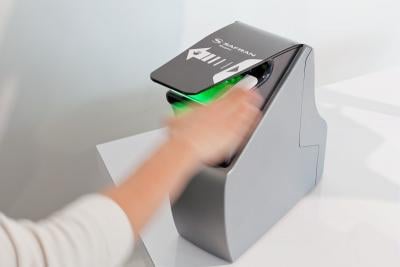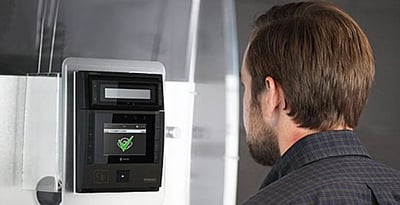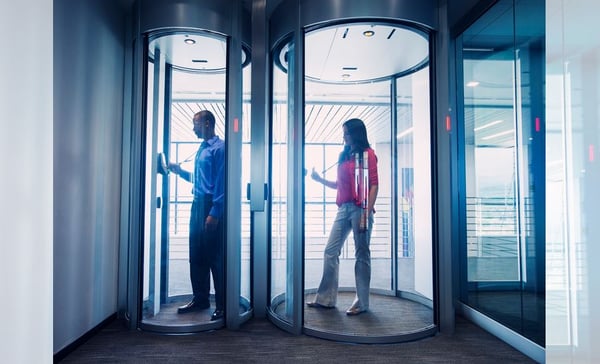Here at Boon Edam, we manufacture security doors and turnstiles that integrate with virtually any access control device. Still, security professionals are curious – what biometric authentication devices are we seeing installed in the field?
We’ve compiled a list of the top biometric devices that are being integrated with security entrances to mitigate the risk of unauthorized entry. We’ll also discuss how biometric devices measure up when coupled with each type of security entrance.
Popular Biometric Authentication Devices
Biometric devices are becoming the standard when it comes to identification and access into secure buildings. Why? Distinguished biological traits – like facial geometry, fingerprints and iris patterns – cannot be easily recreated and will never be forgotten by the user.
Here are some of the most common biometric methods that we see integrated with security entrances.
Facial Recognition
Each human face has approximately 80 distinguishable measurements – distance between the eyes, width of the nose, length of the jawline, for example. These unique measurements are used to identify authorized users.
Fingerprint Technology
Fingerprints have been used to identify people for decades. Many biometric devices today do not even require a user to physically touch the device. Hand-wave technologies are effective at reading fingerprints quickly and effortlessly.
Iris Recognition
When compared to the face or fingerprints, the iris is the most unique. Each person’s iris contains over 200 points of reference, and these points are not likely to change over time, making them a reliable means for granting access.
Each of these biometric methods work to authorize users in a similar way. The devices scan the faces, eyes and/or fingerprints of the user and then compares those unique measurements to an enrollment list of all authorized users. Confirmation = access through the entrance.
Integrating Biometrics with Security Entrances
Biometric devices do an excellent job of verifying an authorized person. But, much of the effectiveness of a biometric device is dependent on what type of entrance it is used in conjunction with. For instance, a biometric device on a swinging door may verify the user, but it will not stop them from holding that swinging door open for other employees.
Here is how biometric authentication devices measure up with the following security entrances:
Tripod & Full Height Turnstiles
Biometric devices won’t do much to increase the security level of a tripod or full height turnstile. These solutions do not have sensors to alert staff should someone jump over the tripod turnstile or, should two people go together through a full height turnstile. In addition, someone could authorize using the biometric device and then allow an intruder to go inside in their place. Often tripod and full height turnstiles are installed outdoors in a layered physical security strategy and the biometric technology is used indoors at another entry point.
Optical Turnstiles & Security Revolving Doors
Biometric authentication devices are often used in conjunction with optical turnstiles and security revolving doors; however, there are some factors to consider.
The authorization device should allow the user to present their biometrics as close to the time they will enter the turnstile or door as possible. Fingerprint recognition devices are the most popular device and will have the least impact on throughput. They also easily integrate using custom pedestals.
Iris scanners are also effective, but will have a much larger impact on throughput since each user will have to stop for several seconds to have their eyes verified. And, aesthetically pleasing integration with the entrance is more difficult to achieve.
Facial recognition devices advertise the ability to pick an authorized face out of the crowd, but this can pose a challenge with turnstiles and security revolving doors. Say a group of 6-8 people is approaching the entrance. While the facial recognition device can pick up the authorized users in the crowd, it cannot control exactly WHO enters the turnstile or door. Therefore, it is possible for an intruder to get inside undetected.
Security Portals
By design, mantrap portals when coupled with biometric devices provide the highest level of assurance against unauthorized entry. This is because they allow only one person to enter through them at a time. Boon Edam’s Circlelock Solo and Combi use a technology called StereoVision to verify a person is alone. Supporting the “intent” of multi-factor authentication, security portals authorize credentials in two distinct steps: (1) outside the portal and (2) inside the portal after the user is confirmed to be alone. This secondary biometric authentication not only confirms the identity of the user, but, most importantly, ensures that the identity matches the first credential that was presented outside the portal.

